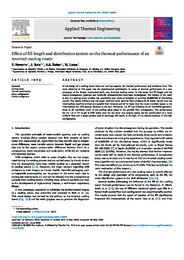Por favor, use este identificador para citar o enlazar este ítem:
https://hdl.handle.net/11000/35395Registro completo de metadatos
| Campo DC | Valor | Lengua/Idioma |
|---|---|---|
| dc.contributor.author | Navarro Cobacho, Pedro | - |
| dc.contributor.author | Ruiz Ramírez, Javier | - |
| dc.contributor.author | Kaiser, Antonio S. | - |
| dc.contributor.author | Lucas Miralles, Manuel | - |
| dc.contributor.other | Departamentos de la UMH::Ingeniería Mecánica y Energía | es_ES |
| dc.date.accessioned | 2025-01-28T13:40:53Z | - |
| dc.date.available | 2025-01-28T13:40:53Z | - |
| dc.date.created | 2023 | - |
| dc.identifier.citation | Applied Thermal Engineering | es_ES |
| dc.identifier.issn | 1873-5606 | - |
| dc.identifier.issn | 1359-4311 | - |
| dc.identifier.uri | https://hdl.handle.net/11000/35395 | - |
| dc.description.abstract | In the design of a cooling tower there are two key aspects, the thermal performance and emissions level. The main objective of this paper was the experimental optimisation in terms of thermal performance of a new prototype of the forced, mechanical-draft, wet, inverted cooling tower. In this sense, the fill length and the nozzle arrangement (position and hydraulic characteristics) have been investigated. The novelty of the work is that the cooling tower studied has practically zero levels of emission of particles (0.00015% of circulating water). The results indicate that the upper manifold (only parallel flow) presents 24 % better results than the intermediate manifold (mixed and parallel flow mixture) and 37 % better than the lower manifold (equal to the intermediate but with greater distance to the fan). Moreover, the fill has influence on all manifolds operation, since in all manifolds much of the cooling takes place in the parallel flow arrangement. The performance for the 1.6 m fill length is 27% better than for the other two lengths tested. So the combination of a more uniform flow and a larger surface area of exchange will result, in the light of the results obtained, in the best configuration. | es_ES |
| dc.format | application/pdf | es_ES |
| dc.format.extent | 13 | es_ES |
| dc.language.iso | eng | es_ES |
| dc.publisher | Elsevier | es_ES |
| dc.relation.ispartofseries | 231 | es_ES |
| dc.rights | info:eu-repo/semantics/openAccess | es_ES |
| dc.rights | Attribution-NonCommercial-NoDerivatives 4.0 Internacional | * |
| dc.rights.uri | http://creativecommons.org/licenses/by-nc-nd/4.0/ | * |
| dc.subject | Cooling tower | es_ES |
| dc.subject | Thermal performance | es_ES |
| dc.subject | Spray configuration | es_ES |
| dc.subject | Nozzle arrangement | es_ES |
| dc.subject.other | CDU::6 - Ciencias aplicadas::62 - Ingeniería. Tecnología::621 - Ingeniería mecánica en general. Tecnología nuclear. Electrotecnia. Maquinaria | es_ES |
| dc.title | Effect of fill length and distribution system on the thermal performance of an inverted cooling tower | es_ES |
| dc.type | info:eu-repo/semantics/article | es_ES |
| dc.relation.publisherversion | https://doi.org/10.1016/j.applthermaleng.2023.120876 | es_ES |

Ver/Abrir:
2023 ATE 231.pdf
2,8 MB
Adobe PDF
Compartir:
 La licencia se describe como: Atribución-NonComercial-NoDerivada 4.0 Internacional.
La licencia se describe como: Atribución-NonComercial-NoDerivada 4.0 Internacional.
.png)